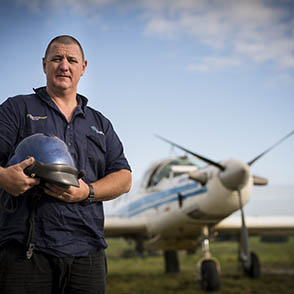Creating safer skies and better sustainability for aerial topdressing
An award winning development in aerial topdressing is making it safer for pilots to navigate one of the world’s most dangerous professions while improving on-farm sustainability.
SpreadSmart™ provides topdressing pilots with an innovative map system for applying fertiliser across New Zealand’s diverse farmlands. The system was recognised at the New Zealand Spatial Excellence Awards last week, winning the Innovation and Commercialisation category.
Ballance Agri-Nutrients GIS Analyst, Andrew Old, says that the reason Ballance developed this system wasn’t only to create better pasture productivity and targeted fertiliser applications around environmentally sensitive areas. One of the key benefits is actually for the pilots, as it allows them to focus on flying.
“Topdressing pilots have one of the most challenging and dangerous professions in the world,” says Mr Old.
“Picture this, you are flying an aircraft at 250 kilometres an hour, navigating up and over hillsides, looking out the window for bush, streams, creeks, powerlines and farm boundaries, and at the same time pulling a lever to control the flow of fertiliser coming out of the hopper. It’s not an easy task.
“SpreadSmart has simply automated the process, by connecting the hopper and hopper controller to a GPS unit. A predefined spread map is loaded into the GPS to control the fertiliser flow and placement.”
The system was developed as part of Ballance’s Clearview Innovations Primary Growth Partnership programme with the Ministry for Primary Industries, designed to improve nitrogen and phosphate management systems. The technology has been fitted into Ballance’s Super Air topdressing division’s aircraft in Wairarapa and King Country and launched in these areas for wider commercial application.
Ballance Science Strategy Manager, Warwick Catto, says SpreadSmart will provide the opportunity to explore different spreading techniques – allowing for the development of fertiliser products that can target certain land features or production limitations.
“This system keeps fertiliser out of waterways, gullies, forestry blocks, tracks and other no-go zones and allows for different fertiliser products to be specifically targeted to different areas of the farm, improving overall production,” says Mr Catto.
“It also combines variable rate application, so different parts of the farm get exactly the volumes of fertiliser they need. With fertiliser one of the largest on-farm costs, precision applications also mean budgets go further, improving farm margins.”
The award judges commented that the submission for SpreadSmart demonstrated a “well-designed and rounded solution that cleverly combines positioning, GPS and aviation technology.”
“The solution has achieved good market uptake and has the potential to deliver significant economic benefits to New Zealand and New Zealand farmers, and also long term environmental benefits.”
Ballance beat finalists Marlborough District Council and fertiliser co-operative Ravensdown to win the award, and is now eligible for the Asia Pacific Spatial Excellence Awards, to be held in Sydney in April next year.
